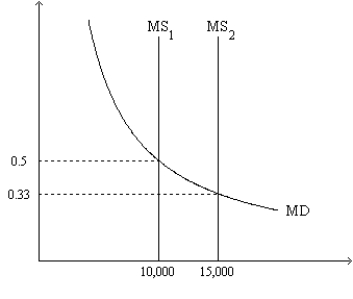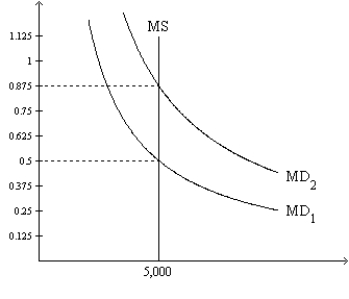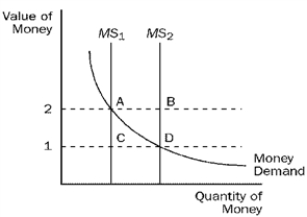A) 6 times its old value.
B) 3 times its old value.
C) 1.5 times its old value.
D) 0.75 times its old value.
F) B) and C)
Correct Answer

verified
Correct Answer
verified
Multiple Choice
Figure 30-3.On the graph,MS represents the money supply and MD represents money demand.The usual quantities are measured along the axes.  -Refer to Figure 30-3.Suppose the relevant money-supply curve is the one labeled MS1;also suppose the economy's real GDP is 30,000 for the year.If the money market is in equilibrium,then the velocity of money is approximately
-Refer to Figure 30-3.Suppose the relevant money-supply curve is the one labeled MS1;also suppose the economy's real GDP is 30,000 for the year.If the money market is in equilibrium,then the velocity of money is approximately
A) 3.0
B) 6.0
C) 9.0
D) 1.5
F) A) and B)
Correct Answer

verified
Correct Answer
verified
Multiple Choice
Figure 30-2.On the graph,MS represents the money supply and MD represents money demand.The usual quantities are measured along the axes.  -Refer to Figure 30-2.What quantity is measured along the horizontal axis?
-Refer to Figure 30-2.What quantity is measured along the horizontal axis?
A) the price level
B) the real interest rate
C) the value of money
D) the quantity of money
F) All of the above
Correct Answer

verified
Correct Answer
verified
Multiple Choice
If P denotes the price of goods and services measured in terms of money,then
A) 1/P represents the value of money measured in terms of goods and services.
B) P can be interpreted as the inflation rate.
C) the supply of money influences the value of P,but the demand for money does not.
D) All of the above are correct.
F) A) and B)
Correct Answer

verified
A
Correct Answer
verified
Multiple Choice
When money is neutral,which of the following increases when the money supply growth rate increases?
A) real output growth
B) real interest rates
C) nominal interest rates
D) the money supply divided by the price level
F) C) and D)
Correct Answer

verified
Correct Answer
verified
Multiple Choice
In the fourteenth century,the Western African Emperor Kankan Musa traveled to Cairo where he gave away much gold,which was in use as a medium of exchange.We would predict that this increase in gold
A) raised both the price level and the value of gold in Cairo.
B) raised the price level,but decreased the value of gold in Cairo.
C) lowered the price level,but increased the value of gold in Cairo.
D) lowered both the price level and the value of gold in Cairo.
F) A) and C)
Correct Answer

verified
Correct Answer
verified
Multiple Choice
The value of money rises as the price level
A) rises,because the number of dollars needed to buy a representative basket of goods rises.
B) rises,because the number of dollars needed to buy a representative basket of goods falls.
C) falls,because the number of dollars needed to buy a representative basket of goods rises.
D) falls,because the number of dollars needed to buy a representative basket of goods falls.
F) All of the above
Correct Answer

verified
D
Correct Answer
verified
Multiple Choice
Figure 30-1  -Refer to Figure 30-1.If the money supply is MS2 and the value of money is 2,then there is an excess
-Refer to Figure 30-1.If the money supply is MS2 and the value of money is 2,then there is an excess
A) demand for money that is represented by the distance between points A and C.
B) demand for money that is represented by the distance between points A and B.
C) supply of money that is represented by the distance between points A and C.
D) supply of money that is represented by the distance between points A and B.
F) All of the above
Correct Answer

verified
D
Correct Answer
verified
Multiple Choice
Figure 30-2.On the graph,MS represents the money supply and MD represents money demand.The usual quantities are measured along the axes.  -Refer to Figure 30-2.Suppose the relevant money-demand curve is the one labeled MD1;also suppose the velocity of money is 4.If the money market is in equilibrium,then the economy's real GDP amounts to
-Refer to Figure 30-2.Suppose the relevant money-demand curve is the one labeled MD1;also suppose the velocity of money is 4.If the money market is in equilibrium,then the economy's real GDP amounts to
A) 2,500.
B) 7,500.
C) 10,000.
D) 40,000.
F) A) and D)
Correct Answer

verified
Correct Answer
verified
Multiple Choice
When the money market is drawn with the value of money on the vertical axis,the value of money decreases if
A) either money demand or money supply shifts right.
B) either money demand or money supply shifts left.
C) money demand shifts right or money supply shifts left.
D) money demand shifts left or money supply shifts right.
F) B) and D)
Correct Answer

verified
Correct Answer
verified
Multiple Choice
Ashley puts money in a savings account at her bank earning 2 percent interest.One year later she takes her money out and notes that prices rose 3 percent.Ashley earned a
A) real interest rate of -1 percent due to inflation.
B) real interest rate of 1 percent due to inflation.
C) nominal interest rate of -1 percent due to inflation.
D) nominal interest rate of 1 percent due to inflation.
F) None of the above
Correct Answer

verified
Correct Answer
verified
Multiple Choice
If Y and M are constant and V doubles,the quantity equation implies that the price level
A) falls to half its original level.
B) doubles.
C) more than doubles.
D) does not change.
F) A) and B)
Correct Answer

verified
Correct Answer
verified
Multiple Choice
When the money market is drawn with the value of money on the vertical axis,long-run equilibrium is obtained when the quantity demanded and quantity supplied of money are equal due to adjustments in
A) the value of money.
B) real interest rates.
C) nominal interest rates.
D) the money supply.
F) C) and D)
Correct Answer

verified
Correct Answer
verified
Multiple Choice
The price level rises if either
A) money demand shifts rightward or money supply shifts leftward;this rise in the price level is associated with a rise in the value of money.
B) money demand shifts rightward or money supply shifts leftward;this rise in the price level is associated with a fall in the value of money.
C) money demand shifts leftward or money supply shifts rightward;this rise in the price level is associated with a rise in the value of money.
D) money demand shifts leftward or money supply shifts rightward;this rise in the price level is associated with a fall in the value of money.
F) All of the above
Correct Answer

verified
Correct Answer
verified
Multiple Choice
When the money market is drawn with the value of money on the vertical axis,the price level increases if
A) either money demand or money supply shifts right.
B) either money demand or money supply shifts left.
C) money demand shifts right or money supply shifts left.
D) money demand shifts left or money supply shifts right.
F) A) and C)
Correct Answer

verified
Correct Answer
verified
Multiple Choice
Suppose that monetary neutrality and the Fisher effect both hold.An increase in the money supply growth rate increases
A) the inflation rate and real interest rates.
B) the inflation rate,but not real interest rates.
C) real interest rates,but not the inflation rate.
D) neither the inflation rate nor real interest rates.
F) C) and D)
Correct Answer

verified
Correct Answer
verified
Multiple Choice
According to the classical dichotomy,which of the following is influenced by monetary factors?
A) the real wage.
B) the real interest rate.
C) the nominal interest rate.
D) All of the above are correct.
F) C) and D)
Correct Answer

verified
Correct Answer
verified
Multiple Choice
When deflation exists,
A) the real interest rate is less than the nominal interest rate.
B) the real interest rate is greater than the nominal interest rate.
C) the real interest rate and inflation are less than the nominal interest rate.
D) prices rise.
F) A) and C)
Correct Answer

verified
Correct Answer
verified
Multiple Choice
The economy of Mainland uses gold as its money.If the government discovers a large reserve of gold on their land
A) the supply of money decreases and the value of money rises.
B) the supply of money increases and the value of money falls.
C) the demand for money increases and the value of money rises.
D) the demand for money decreases and the value of money falls.
F) A) and D)
Correct Answer

verified
Correct Answer
verified
Multiple Choice
Evidence concerning hyperinflation indicates a clear link between the money supply and the price level for
A) Austria in the 1920's.
B) Hungary in the 1920's.
C) Poland in the 1920's.
D) All of the above are correct.
F) None of the above
Correct Answer

verified
Correct Answer
verified
Showing 1 - 20 of 245
Related Exams